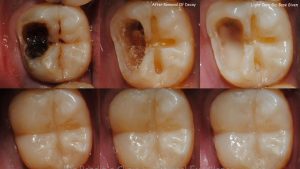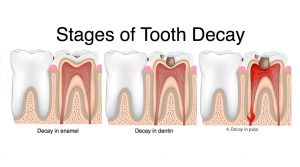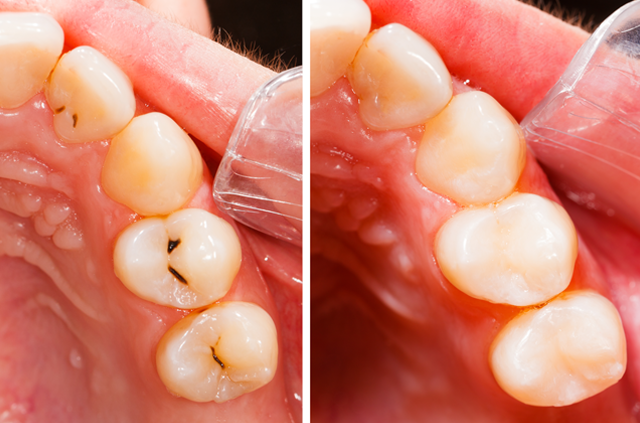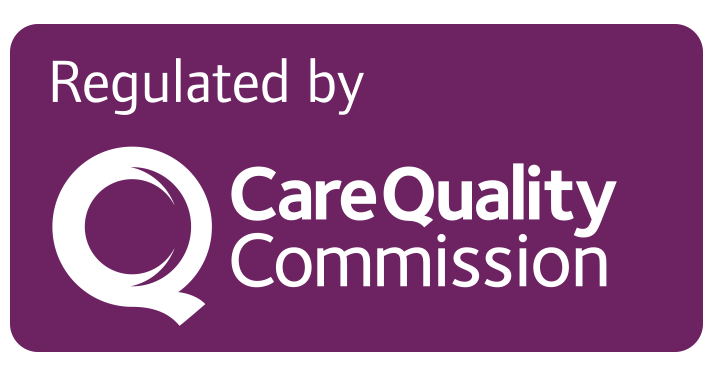Dental caries is the scientific term for tooth decay. When you eat food and drinks, high in carbohydrates, the bacteria in the plaque turns what has been consumed by the energy they need, producing acid at the same time. If the plaque is allowed to build up, the acid can begin to dissolve the tooth’s enamel and the layer under it. This segment, the dentin, can then develop holes known as cavities. This is tooth decay.
The plaque forms most easily in certain places. These include:
• Cracks, pits or grooves in the back teeth
• Between teeth
• Around dental fillings or bridgework
• Near the gum line
Initially, decay is minimal to see, but it gets larger over time. Eventually, if corrosion is not treated, the bacteria will enter the pulp (the soft centre of the tooth that contains nerves and blood vessels). At this stage, your nerves will be exposed to bacteria, usually making your tooth painful. These bacteria can cause dental abscesses in the pulp, and the infection could spread to the bone.
Tooth roots exposed by receding gums also can develop decay. The root’s outer layer, cementum, is not as thick as enamel. Acids from plaque bacteria can dissolve it rapidly.
Symptoms of Types of Dental Decay
Early caries may not have any signs. Later, when the rot has eaten through the enamel, the teeth may be sensitive to sweet, hot or cold foods or drinks.
Tooth decay may not cause any pain. However, if you have dental caries you might have:
1.A toothache, either continuous pain keeping you awake or occasional sharp pain without an apparent cause
2. You may also feel tooth sensitivity when eating or drinking something hot, cold or sweet.
3. Grey, brown or black spots appearing on the surfaces of the teeth.
4. Bad breath
5. An unpleasant taste in your mouth

It is essential to visit your dentist regularly so that early Types of Dental Decay can be treated as soon as possible and prevention can begin. Tooth decay is much more comfortable and cheaper to address in its early stages. Dentists can usually identify tooth decay and further problems, with a simple examination or X-ray. The decline can be treated with aesthetic composite fillings, ceramic crowns or veneers. Adults and children should have a check-up at least once a year.
Diagnosis
A dentist will look for caries at each office visit. The dentist will look at the teeth and may probe them with a tool called an explorer to search for pits or areas of damage.
Your dentist will take X-rays of your teeth on a set schedule, and also if a problem is suspected. They can show newly forming decay, particularly between teeth. They also show the more advanced degeneration, including whether any has reached the pulp and whether the tooth requires a root canal treatment.
Newer devices also can help to detect tooth decay. They are useful in some situations. The one most commonly used in dental offices is a liquid dye or stain. Your dentist brushes the nontoxic dye over your teeth, then rinses it off with water. It rinses away cleanly from healthy areas but sticks to the decayed areas.
Some dentists also use high-tech devices such as lasers to detect cavities. In some situations, these devices can detect very early tooth decay, which can then be reversed.
Expected Duration
Caries caught in the very early stages can be reversed. White spots may indicate early caries that has not yet eroded through the enamel. Early caries may be modified if the acid damage is stopped and the tooth is given a chance to repair itself naturally.
Caries that has destroyed enamel cannot be reversed. Most caries will continue to get worse and go deeper. With time, the tooth may decay down to the root. How long this takes will vary from person to person. Caries can erode to an extreme level within months or years.
Prevention of dental decay
Although Types of Dental Decay is a common problem, it is often entirely preventable. The best way to avoid it is to keep your teeth and gums as healthy and clean as possible. Therefore, you should:
1. Clean your teeth properly with fluoride toothpaste twice a day, using floss and an interdental brush at least once a day. This will help to reduce the number of bacteria in your mouth.
2. Visit your dentist regularly. They will decide how often they need to see you based on the condition of your mouth, teeth and gums.
3. You can reduce the amount of tooth-damaging acid in your mouth by eating sugary or starchy foods less often during the day. Your mouth will remain acidic for several hours after you eat. Therefore, you are more likely to prevent caries if you avoid between-meal snacks or within an hour of going to bed – some medications can also contain sugar, so it’s best to look for sugar-free alternatives where possible
4. Avoid smoking or drinking alcohol excessively – tobacco can interfere with saliva production, which helps to keep your teeth clean; alcohol can contribute to the erosion of tooth enamel
5. Another way to reduce your risk of cavities is through the use of fluoride, which strengthens teeth. A dentist can evaluate your risk of caries and then suggest appropriate fluoride treatments. Fluoride in water strengthens teeth from within, as they develop, and also on the outside. Dentists also can paint fluoride varnish on children’s primary teeth to protect them from decay.
6. You also can use antibacterial mouth rinses to reduce the levels of bacteria that cause cavities. Other rinses neutralise the acid in your mouth to make it less friendly to the growth of these bacteria.
7. Sugar-free chewing gum helps to decrease bacterial growth.
8. In adults and children, molars can be protected with sealants. Dentists also can use sealants on molars that have early signs of tooth decay, as long as it has not broken through the enamel.
9. See your dentist or GP if you have a persistently dry mouth –this may be caused by certain medicines, treatment or medical conditions
Protecting your child’s teeth
Establishing good eating habits, by limiting sugary snacks and drinks, can help your child avoid tooth decay. Regular visits to the dentist at an early age should also be encouraged.
It’s important to teach your child how to clean their teeth regularly and adequately. Your dentist can show you how to do this. Children should still brush their teeth twice a day, especially before bedtime.
Treatment of tooth decay depends on how advanced it is.
For early-stage tooth decay – your dentist will talk to you about the amount of sugar in your diet and the times you eat. They may apply a fluoride gel, varnish or paste to the area. Fluoride helps to protect teeth by strengthening the enamel, making teeth more resistant to the acids from the plaque that can cause tooth decay.
If the Types of Dental Decay is not too extensive, then the dentist will clean it and restore the tooth. This involves removing the dental decay, offering a local anaesthetic to numb the tooth and filling the hole.
If a cavity is large, the remaining tooth may not be able to support enough filling material to repair it. In this case, the dentist will remove the decay and cover the tooth with a ceramic inlay, onlay or a crown.
When the tooth is so severely damaged that it cannot be restored, it may need to be removed. Your dentist may be able to replace the tooth with a partial denture, bridge or dental implant.
Sometimes bacteria may infect the pulp inside the tooth even if the part of the tooth you can see remains relatively intact. In this case, the tooth will need root canal treatment. A general dentist or an endodontist will remove the pulp, disinfect the canals of the tooth and replace it with an inert material. In most cases, the tooth will need a crown.
Prognosis
If caries are not treated, it likely will cause the tooth to decay significantly. Eventually, uncontrolled decay may destroy the tooth.
Having caries increases your risk of it spreading for several reasons:
• The more decay you have, the more bacteria exist in your mouth.
• The same oral care and dietary habits that led to the decay of your teeth will cause more caries.
• Bacteria tend to stick to fillings and other restorations more than to smooth teeth, so those areas will be more likely to have new caries.
• Cracks or gaps in the fillings may allow bacteria and food to enter the tooth, leading to decay from beneath.
When To Call a Professional
The early stages of decay are usually painless. Only regular dental examinations and X-rays (or other caries-detecting devices) can show early trouble. If your teeth become sensitive to chewing or too hot, cold or sweet foods or drinks, contact your dentist.




